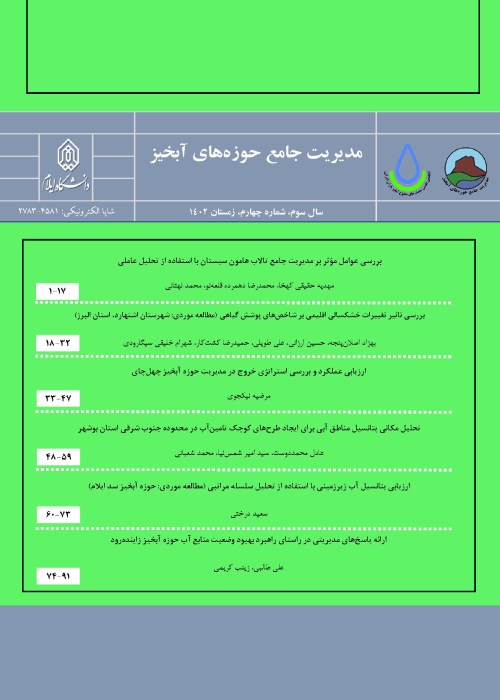Application of Spatial Statistics in Evaluating the Spatial Correlation Patterns of Noise Pollution in the Central Part of Zayandeh-Rood Watershed
Noise pollution is an environmental issue that threatens the human health and the survival of other living organisms along with air, soil, and water pollution. It is also considered as one of the important criteria in determining the quality of life in the world. Various sources such as growing urbanization, transportation, spatial heterogeneity of land use types and improper planning can increase noise pollution. Therefore, assessment and zoning of noise pollution, which is one of the effective ways of identifying the areas having noise pollution, can play an important role in controlling this pollution.Accordingly, interpolation approaches are an appropriate tool for identifying and evaluating areas with different pollution ranges. Although interpolation approaches are successful in zoning environmental parameters, they do not specify how these parameters change. In other words, they do not determine the type of spatial distribution patterns of these parameters. Therefore, spatial statistical methods are a suitable tool for determining the spatial distribution patterns of environmental parameters. In recent years, spatial statistical approaches have been widely used in the environmental sciences, and in recent studies, researchers have used the capabilities of these methods to identify and examine the spatial correlation of homogeneous areas. Hence, the purpose of this study is to investigate and evaluate the spatial correlation patterns of noise pollution in the central part of Zayandeh-Rood watershed using spatial statistical approaches.
The research area is the central part of Zayandeh-Rood watershed, which is located between 32°19′ to 32°56 north latitudes and 51°12′ to 51°59′ east longitudes, and includes parts of Isfahan, Shahinshahr, Khomeini Shahr, Najafabad and Falavarjan. This region covers an area of 1181 Km2. The average annual temperature in this region is 16.7 ° C and the average rainfall is 116.9 mm. This region, like other areas of Isfahan province, has a traffic problem due to the uncontrolled increase of personal vehicles, which has caused people to turn to highways and sidewalks to avoid traffic. The problem of traffic in this region lies in the lack of proper infrastructure to control urban and suburban transportation. In this research, to evaluate and zone noise pollution, 36 stations were randomly selected in the study area in the first place. Then, the sound pressure level was measured at certain hours of the week using the Bruel & Kjaer sound level meter while observing the principles of noise measurement including distance from building, the stability of sound meter at a certain height, and reduction of the error caused by vibration of air molecules.. In the next step, spatial correlation patterns of noise pollution were evaluated using spatial statistical approaches including Global Moran Index, Hotspot analysis, Anselin Local Moran's I, and Cluster/Outlier Analysis with Rendering. In the end, the spatial accuracy of the prepared maps was investigated using Receiving Operator Characteristic (ROC) for different approaches. In order to evaluate the spatial accuracy by this index, in addition to the map obtained from different approaches of spatial statistics, a reference map is also needed. In this study, one third of the points used for noise pollution zoning were randomly selected and were used as the reference map to assess the spatial accuracy of the maps obtained from the previous step.
The result of noise pollution zoning in the study area indicated that the noise intensity changes range from 47.59 to 77.48 decibels. According to the noise pollution zoning map, the highest noise level belongs to the eastern and northern parts of the region. These areas include important urban areas, such as Isfahan, Khomeini-Shahr, Shahinshahr and Najafabad. The southern and central part of the study area, which has a high density of agricultural lands and green spaces, has a lower noise level. This issue has an effect on the results of spatial correlation assessment of noise pollution in the target area; areas with high noise pollution levels follow the correlation pattern of high clusters, while the areas with low noise pollution involve a low clustering pattern. The application of the Receiving Operator Characteristic (ROC) showed that the Hot-spot analysis approach has higher accuracy than the other two approaches in evaluating the spatial correlation patterns of noise pollution. The area under ROC revealed that the Hotspot analysis approach is more than 96% reliable in identifying focal areas with high noise pollution. Given that the probability for the other two approaches is 92% and 89%, respectively, and considering that the rate of the area under the ROC is very close to 1, the efficiency of these two approaches in identifying and determining areas with noise pollution is acceptable. Furthermore, considering the Receiving Operator Characteristic (ROC) of all three methods, the accordance degree of these methods with ground reality is spatially high.
The results of this study revealed that evaluating the accuracy of different approaches in examining the distribution patterns of various phenomena (such as noise pollution) has an effective role in planning and scientific management of the land based on the land-use planning principles. According to the findings of this study, the simultaneous study of the spatial statistical approaches provides a fuller understanding of how noise pollution is distributed in the study area.
- حق عضویت دریافتی صرف حمایت از نشریات عضو و نگهداری، تکمیل و توسعه مگیران میشود.
- پرداخت حق اشتراک و دانلود مقالات اجازه بازنشر آن در سایر رسانههای چاپی و دیجیتال را به کاربر نمیدهد.



